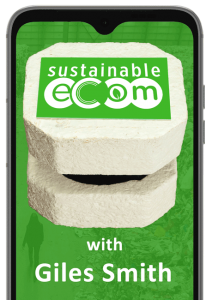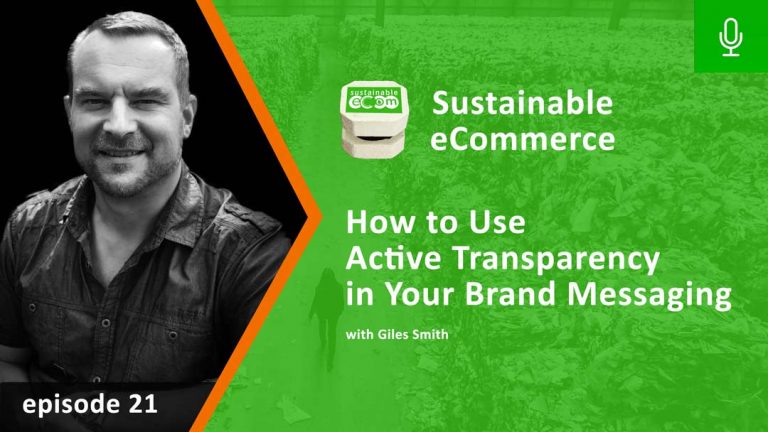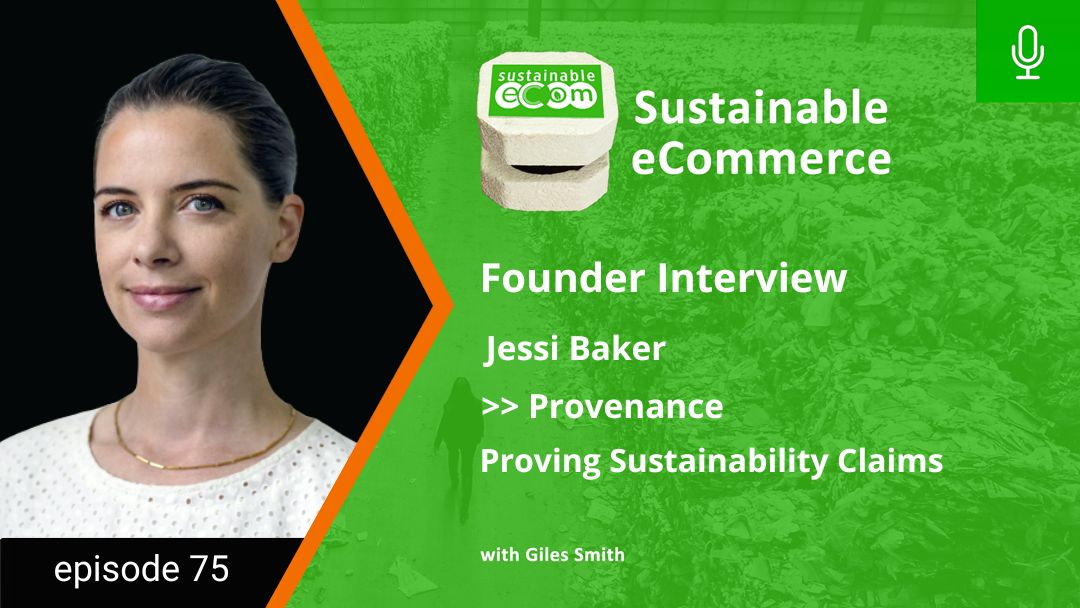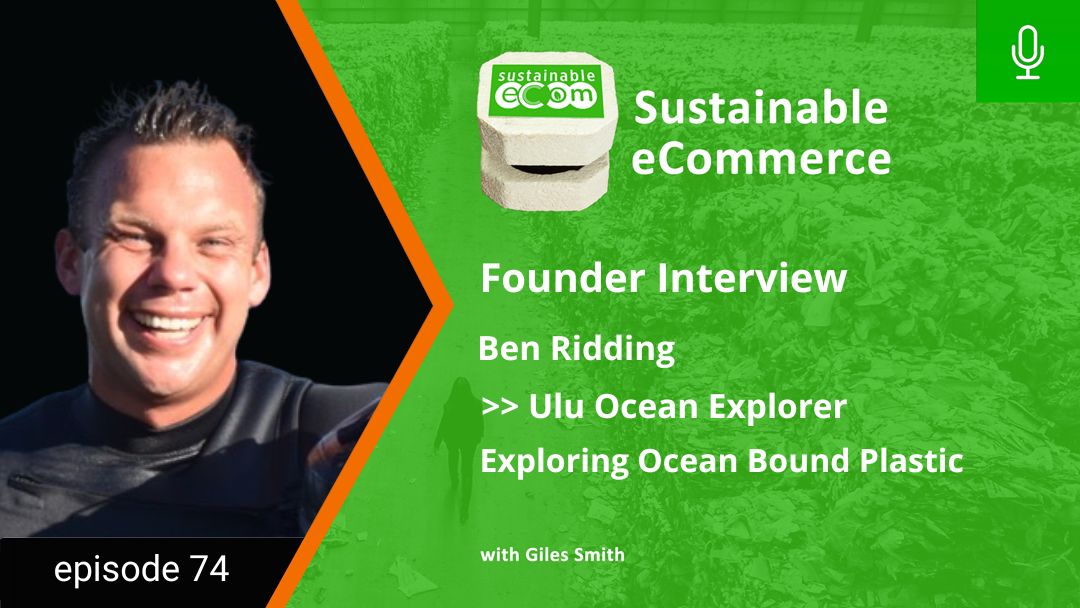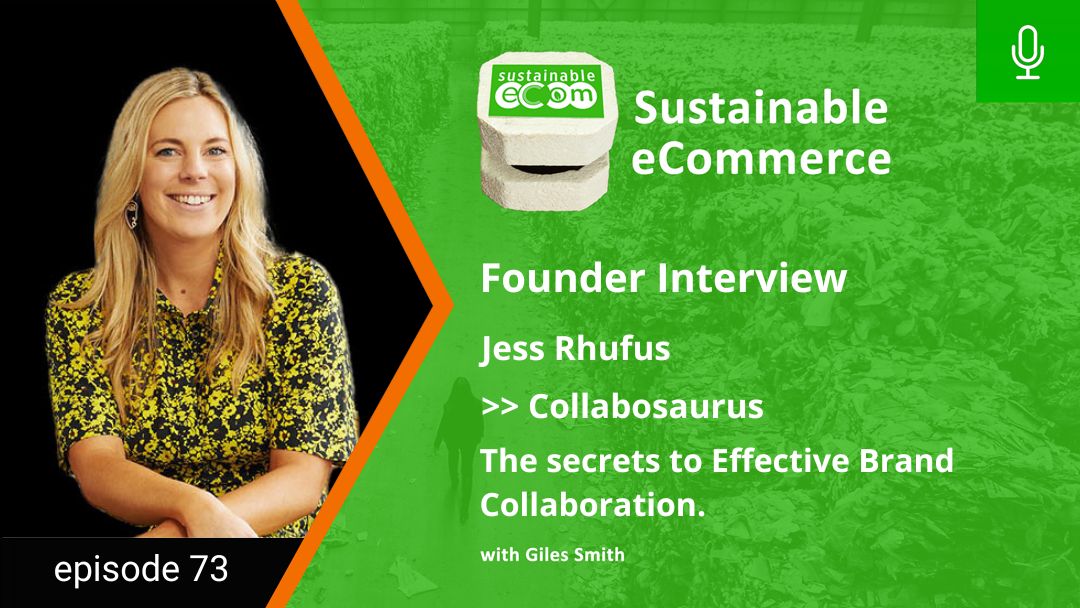Welcome to Episode 21 of the Sustainable Ecommerce Podcast
In today's show, I thought it would be useful to summarise a common thread that’s weaved its way through many of the interviews we’ve had so far, and comes up as a challenging topic in one form or another among every single one of the businesses we work with.
That topic relates to messaging and being able to tell your brand story in an open, transparent and compelling way.
Your Brand's Success Matters to the Planet!
I wanted to start by expressing my deep belief as to why being a sustainable brand owner matters. I’m not just referring to the incredible people I’ve interviewed on the show, but you guys out there building purpose driven brands as well.
Back in January 2020, before Sustainable Ecommerce was born, I did a Facebook live where I gave some predictions about what the next decade would bring. Among those was that sustainability was going to become mainstream, and that it was the direct to consumer brands making sustainable products that collectively were going to have the greatest impact in cleaning up our planet.
Your brand’s success really does matter. Through your choices and your direct connection to consumers, it’s the DTC brands together that stand the best chance of helping navigate away from the current and looming environmental crises. By making your products from sustainable materials, you’re embedding an understanding and expectation in consumers that such a thing is not just possible, but should be expected.
So it’s been really interesting to hear the founders behind some of the brands I’ve had on the show sharing that view. For example here’s what Mike Smith from Zero Co has to say about why DTC brands matter:
Mike Smith: So my hypothesis about how this plastic problem is going to be solved globally has really led to everything we’ve done from a tonality and communications perspective around the business. I believe that it’s not governments who solve this problem. Governments are really inefficient and there’s so much debating and arguing and squabbling that goes on. We’ve known about this problem for 50 or 60 years now, and no one’s done anything about it. I think it isn’t going to be big business that solves this problem, because they are so invested in the petrochemical industry and in plastic production. They’ve got these huge billion-dollar supply chains that are built to make and pump out single use plastic.
And I don’t think it’s going to be charities who solve this problem because they don’t have the global scale or kind of the innovation credentials to solve it. So my hypothesis from day one has been that I believe it’s going to be a movement of people, everyday. People from all around the world who makes small lifestyle changes, which add up to big, huge impacts on a global scale.
So that’s how I think we’re going to solve this problem globally. We have from day one said we are going to build a people-powered solution to the plastic problem. And therefore, everything from day one is about building community and inspiring people to come on this journey with us.
Nobody has a perfect solution to this problem. ZeroCo is not a perfect solution. But if we all work together, we will get through the stages of innovation that we need to go through to find a really, really great solution. So, from day one, it has just been about putting the community, putting everyday people right at the heart of everything we do.
Coming back to my original prediction, I thought that sustainability would be mainstream by the middle of this decade, but the pandemic has really escalated that. Late last year, in October 2021 special research report of over 10,000 consumers, consulting firm Simon Kucher + Partners identified that 80% of consumers now feel that sustainability is important and they want to live more sustainable lives. And in addition, about half of all consumers of all consumers consider sustainability to be an important factor when actually making purchasing decisions.
If 80% of consumers want to live more sustainably, and half would make buying decisions based on the sustainability of a product, we can pretty confidently say that demand is no longer restricted to eco-warriors, and is shifting rapidly towards mainstream, if it isn’t there already.
If Sustainability is Mainstream - Why Does That Matter?
Why does this matter? Well, if sustainability has gone mainstream, it frankly calls for an entirely different approach to your brand messaging and how you tell your story.
3 Years ago, it’s likely that as a sustainable brand, your messaging was targeted towards highly conscious eco-worriers who were actively seeking better options from a sea of unsustainable alternatives. They were clued up, motivated to buy based on their values, and without wanting to trivialise the sales process, you basically had them at hello.
But today’s consumer is different. The competitive landscape is much busier as brands large & small try to capitalise on this increased demand. The eco-warriors are seasoned, they are much more educated, know what they’re looking for and importantly have become attuned to sniffing out the truly good brands and products from those making dubious claims. And of course, you now have rapidly expanding audience of mainstream users who are motivated to make better choices, but they don’t necessarily know how. To help them, you need to capture & communicate your story in a framework they understand. When I spoke to my guest Austin Simms, Founder & CEO at Dayrize about the importance of story, here’s what he had to say:
Austin Simms: I love that question. That’s, it’s so important for us. We need to be telling the story and proudly telling the story about sustainability. Consumers want this, we know they do. They want this level of transparency.
There are emerging brands out there that are making amazing sustainable products. They’re disrupting the market and they need to be celebrated. So I really encourage the brands to get into the storytelling and be proud about it and focused on the positives of it. Lean into the story, tell your brand story, be proud of the sustainability and focus it in a positive sense.
Of course, the reality is nothing’s perfect. Sustainability is an ever-changing space of materials, understanding and techniques. The bigger your brand, the more high-profile your reputation has become, the more daunting an risky it can seem to promote the good work your brand is doing, especially if it hasn’t grown from the ground up with sustainability at its core. As Kiarne Treacy, founder of Sustainable Choice pointed out, big organisations are often the ones least willing to be open about the progress they are making:
Kiarne Treacy: There are many businesses, big businesses that have pages and pages of sustainability reports, but they are reluctant to communicate any of it because they are so frightened of being accused of greenwashing.
But it’s not just the big brands struggling to convey their message. Small brands often lack the credibility and reputation to simply make statements about their product or process sustainability and have that turn into an instantly convincing story. Yet, with mainstream online consumers looking to buy products and make informed choices, conveying the brand message quickly and in a compelling way has never been more vital.
So how do you do that?
Well, over the past year at Sustainable Ecommerce we’ve been developing a repeatable framework you can use you to clarify and communicate your message in a way that will quickly resonate with your target customers. We call it the Purpose Marketing Playbook.
Introducing the Purpose Marketing Playbook
There are three primary pillars to the framework, called Solving Your Customers Problem; Enrolling Heroes and Active Transparency.
Each of which form an important component to attracting your audience and converting them into customers, but for today’s show I wanted to focus on Active Transparency.
The word transparency is often associated with supply chains, showing what things are made of, how they are made, and where they are sourced from and how they arrive at the purchaser’s door.
By contrast Active Transparency as a cornerstone of the Purpose Market Playbook refers to the activities you can conduct to engage your brand’s customer base in your journey to sustainability. I do like the simplicity of arranging things in groups of 3, and so there are 3 pillars to nailing Active Transparency: Measurable Impact; Active Updates and Education.
So let’s go through each of these.
Firstly, measurable impact. Understanding sustainability is HARD. There is so much spin put out in favour of one material or another that its basically impossible for the average consumer to know what to choose. This kind of approach stems I think from old school feature based marketing, which ultimately leads to the customer being baffled by their choices, not informed by them. I’d like to propose that we turn this kind of transparency on its head and focus on the measurable impact our customer will have when purchasing our product or using our service. If you’re selling a garment of clothing for example, can you show the customer how choosing your product will have a measurably smaller impact on the world than those of your competitors? Can you articulate how using your product after purchase will have an impact in the world? Let’s take Boody as an example.

If you don’t know Boody, they are a wonderful Australian underwear brand styling themselves as the Official Underwear of the Entire Planet. Instead of bamboozling the user with all the facts & figures of bamboo rayon (pun intended), they prominently show the impact of choosing each specific items in terms that a customer can understand. For example, the transport emissions avoided, energy and water saved compared to standard items and the amount of land farmed without pesticides.
But they don’t stop there. When you order from them, your account shows a summary of the impact from all the items you’ve purchased, giving you as the consumer highly visibility into how your own choices are impacting the world. It’s a fabulous & rewarding way to make the customer feel like a hero, enrol them in your mission and ensure they keep coming back to you.
The second pillar, Active Updates; refers to treating your customers like partners in your mission, and as a result keeping them abreast of not only your shared mission goals, but also your progress. Being transparent about specifically what your brand is trying to achieve provides a clear focal point for your customers to understand your mission, and giving them regular updates helps them feel a part of the solution and re-assures them they’ve chosen the right bus to get to that destination.
I know many brand owners feel very nervous about progress transparency. That’s understandable because as we all know, not everything goes to plan. But, being mission driven is a very important foundation for transparency, as Mike Smith explains in relation to Zero Co’s principle of radical transparency:
Mike Smith: So for us, it’s about always putting the mission at the front of everything that we do. We always lead with the mission. We use that as our north star, every time there’s a decision to make we say, does this get us closer to achieving our mission? And if it doesn’t, then it’s not the right thing for the business to do. And so having so much belief in this mission and this cause allows us to just not get distracted, not get sidetracked.
We talk openly to the public about where we’re trying to get to and it’s going to take us a decade to get there. We may never get there, but if we just keep pushing in that direction and don’t let anything derail us, then that’s how we’re going to get to our goal. Right. So having that as the center-point of the kind of philosophy allows us to go out and just tell people about all of the things that go wrong.
It’s all part of the journey of getting to the solution.
But our posts about when things don’t go according to plan, they are the most engaging forms of content that we produce! We get the most likes. We get the most shares. People just love the fact that we’re being honest and we’re owning up to them. The single most powerful type of communication that we have in our arsenal is radically transparency.
When it comes time to give your customers mission updates, there aren’t really any fixed rules about the format for updates, but to keep your customers enrolled and engaged, you ideally want to do it every 4-6 weeks. Each of your updates should have the following objectives in mind:
- You want to remind the customer and your customer community that they are the heroes in your mission by showing them the impact they are having. Give them a little endorphin hit from the feel-good news will encourage them to keep opening messages from you.
- Each message should be designed to garner deeper engagement & connectivity with your audience. Help them to understand how working with you means they are part of something bigger and meaningful.
- Lastly you want to show momentum. Never forget that customers can choose to purchase from your competitors. Showing them that they’ve joined a winning team and that through you their actions mean something is a great way to remind them they are in safe hands!
Additionally, don’t underestimate the power of keeping your community updated in terms of keeping you on track to achieve your goals!
How to Announce Good News
- Firstly, remind everyone what your shared goal is, and make it clear what your progress to date has been so that they have a clear understanding of the big picture.
- When you give updates, make sure you include tangible and relatable numbers like we discussed earlier:
- We’ve saved 10,000 single use bottles from landfill
- Our T-shirts now generate 50% less CO2 – that’s 500 grammes of carbon dioxide less than a regular shirt
- We’ve achieved our goal of planting 70,000 trees. Thanks to you, our shared forest now covers nearly 100 football fields!
- It’s important to remind the readers what every purchase from you means in terms of progress to your goal. When you do this openly, you can invite them to purchase from you again in the same message!
- Perhaps most important of all, keep the tone positive. While it can be useful to sprinkle in some alarming statistics in to help keep people on task, customers won’t continue to open your messages if you bombard them with negative information. There’s enough of that in the world and your brand needs to be a beacon of hope.
How to Handle Bad News
Not everything goes to plan! When your brand is mission-driven and you’ve done a great job of enrolling your customers, they will rally to support you when things go off track. Bad news transparency pieces can actually be some of the most engaged content you can create, and when handled correctly can build an even deeper level of trust.
Here are some thoughts to guide you:
- State the facts & don’t sugar coat
- Show why the event or result is not aligned with your collective mission
- The person nominated as the Guide needs to front up on camera. You’ll be demonstrating your emotional commitment and communicating much more than the simple text ever could.
- Mistakes get made all the time, what’s important is how you respond to them. Show what you’re doing about it & ideally how the issue will be prevented going forward.
As a very practical first step, make sure to include what we call a benchmark Update in the first email of your Welcome Sequence
Here, you want to refresh the customer on your mission, commit to the 12 month mission goal, and indicate to the customer what progress you’ve already made.
Referring back to the objectives of active updates, you also want to remind them how their interaction with your brand contributes to that goal, and most importantly of all, make the content of the email about your customer, not just about your brand.
Active Transparency: Education
Most brands education focuses on how to use their products better, how to get the most from their purchase and solve their problems. Obviously, there’s huge value in that, and you should definitely continue to produce and share that content, especially if you can gather up some great case studies showing how your customers lives have improved as a result of buying from you.
But when it comes to purpose-based marketing, we’re also talking about providing education as a way of upskilling your army to fight the good fight aligned with your mission.
As we discussed earlier, sustainability is a constantly unfolding journey for both you and your customer. Recognising that allows you to bring humility to your role as their guide, opening the opportunity to educate them on the things you’ve learned so that they can also make better choices and have an ongoing impact in association with your brand.
Quite a few of my guests over the series have commented on how sharing their own journey of discovery has led to the creation of a vibrant and highly engaged community. For example, let’s hear again from Lottie Dalziel from Banish:
Lottie Dalziel: The education side of things has been really key to us. It’s really set us apart from other marketplaces because we aren’t just here to sell. We’re here to teach people. Most of our customers start with us when they’re just dipping their toes in and making small, sustainable steps. And we want to give them a safe platform so that they can learn. We want to be really accepting of everybody because that’s something that I found when personally I was entering the space is there was so much negativity, and there was so much telling people what they were doing wrong. But there wasn’t enough about showing them how to do right. So that’s been a really cool thing for us.
Pearl Chan too explains just what impact sharing her journey has had one the loyalty, expressed through lense repurchase rate of her customers at Resparkle:
Pearl Chan: We have a very loyal community of customers. 60% or more are repeat buyers and we have phenomenal open rates on our email campaigns.
When we post on social media about our journey or behind the scenes, we do get very very good engagement. So I think people really see and identify with our values and what we stand for. And I think people generally love to support small local brands too.
So, providing regular, scheduled educational content in easily consumed formats can be a very powerful marketing and impact generation tool.
- It helps your brand transcend from simply a source of product to being perceived as a valuable guide in the customer’s life
- Over time you build huge authority from the asset of educational material
- When used on your store it can be a massive boost to SEO
- Great quality content can be used to generate backlinks, encourage shares and can be repurposed easily across multiple media.
- Helping your heroes achieve more multiplies the impact of your brand mission
Something that is often overlooked when creating education content is that for it to have power and be acted upon, there needs to be a trusted relationship between the student (the customer) and the teacher (the guide).
This requires there to be a ‘face’ to the brand, a person with both the empathy and authority to carry the trusted relationship forward. Often, this is where big brands fail, and where small founder-led business can gain real traction. Its one of the reasons why Banish and Resparkle have enjoyed such great success, because their founders have taken direct ownership of being the guide.
If you’re a single founder or solopreneur, that means you’ll be the guide. In a co-founded business, you’ll need to pick one of the founders to take this role.
Now we all know that creating content is hard, it takes time and effort. One of the most common objections I hear from brand owners to justify avoidance of creating education content is that they don’t see any results from it. And that’s fair – if no-one is responding to your content, it certainly isn’t going to have the impact either for your brand or for the world that you need it to.
So to help you with that and round out today’s show, here are 8 tips to help you structure you content for maximum impact.
8 Tips for Generating Impact From Your Educational Content
- Educational content is always more compelling when it is action based rather than purely academic. Your aim for each piece is to explain one practical, actionable way to solve the customer’s problem.
- Always start by framing the problem. In order for the customer to be interested, it obviously needs to be something they are struggling with. Show empathy by using examples from your own life, or select an example of a specific customer who was experiencing the issue. You can focus on any of the problems you identified for your avatar as well as anything related to your mission.
- Give them a simple set of steps to solve the problem, in other words a plan. Make it simple enough that they feel confident in taking it away and achieving it themselves.
- Show the success state after following your instructions. Much like buying your product, they need to clearly see what life will be like for them after following your suggestions.
- Tie the result back to your collective impact and make them feel good about being the hero. Show how conducting the activity contributes to or even expands on the mission goal
- Include images to demonstrate key points- especially when using your products.
- Never talk down to the customer. This relationship is a guide-hero not teacher-first grade student relationship. That means it’s a level playing field. Use simple wording and avoid jargon and anything that might make the customer feel inferior or leave them confused.
- Provide a strong call to action at the end to encourage them to put your suggestions to the test. Ask them to share their experience on social (and provide a direct link to help them do that).
So I hope you’ll put this concept of active transparency into play for your own brand. Help you customers understand how buying from you makes it easy for them to have an impact. Keep them close with regular updates, and make your brand an integral part of their journey through education.
Please do subscribe and follow Sustainable Ecommerce on Linked In to make sure you hear the latest updates from other amazing sustainable brand founders!





